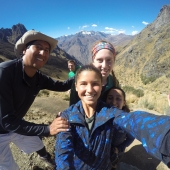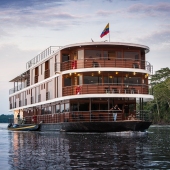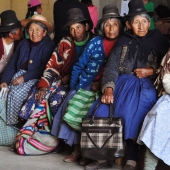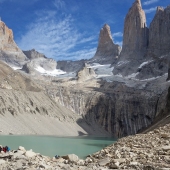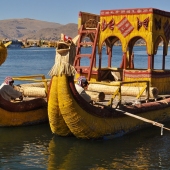
Why You Need To Travel With A Thermometer: TSA Checking Temperatures
Finally, we're happy to report that Peru and Ecuador have ended their states of emergency and eliminated all covid restrictions. Foreigners with valid passports can enter as before the start of the pandemic. Chile and Bolivia are still officially asking for proof of covid vaccines or PCR tests upon entry. This is subject to change, so it's worth it to monitor the protocols. Sherpa.com and LatamAirlines.com both have interactive tools for checking the status of entry to each country. If you are transiting through another country on the way to a country without any covid restrictions, this is a reminder to double check the arrival protocols of the country you're transiting through, even if you plan to stay in the airport.
What do you need to know about traveling in South America after the pandemic?
It's recommended that foreigners buy bottled drinking water or bring a purification device. even when brushing your teeth. After testing and using various devices we finally found what we think is one of the best, and easiest to use, portable water filters for travelers. We're even able to offer a discount code: CLICK HERE to read more and buy if you choose to.
Although thermometers are no longer being used to monitor fevers, you may want to carry one in your bag for your own use.
In South America, citizens are no longer wearing masks, social distancing and dealing with other covid restrictions in Peru and Ecuador. Meanwhile our tour guides in Chile report that arrival protocols are not being enforced except for random testing on arrival in Santiago airport.
While having an elevated temperature may not always be a big deal, what happens if you have a fever? Should you travel? The risk of being quarantined due to fever is very low depending on where you travel. Unless you voluntariliy check yourself for fever, it's not likely anyone else will notice. But having a fever could be an indicator of illness or something else. This is the reason travelers need to learn about fever and how it affects their body before they get to the airport. What is normal for you? What does a fever feel like? Should you suppress your fever with medication? Should you isolate yourself?
Why You Should Travel With Your Own Thermometer
I don't believe that airlines, airports and businesses that cater to tourists, are still tracking people for signs of illness in South America. But if you or someone you're traveling with exhibits obvious symptoms of illness, it's just common sense to limit your exposure to others. What should you do? Here's where having advance information about your temperature could save you time and possibly money if you're at risk of being delayed. Traveling with your own thermometer makes perfect sense. Add it to your travel kit. It doesn't take up much room at all.
Should you bring a pulse - oximeter on your trip to Machu Picchu?
A pulse-oximeter is a small battery-powered device that clips on the end of your finger and measures your pulse (heartrate) as well as the amount of oxygen in your blood. I think this tiny tool is useful, not so much because of the covid situation, but because most people going to Machu Picchu are coming from sea level where there is more oxygen in the air. At sea level a healthy O2 saturation result would be over 95%. It's always best to play around with your device at sea level and get a baseline reading before you use it at high altitude. I've flown most of the high altitude airports in South America (from sea level) and I like tracking my reaction to the altitude. The worse altitude sickness I experienced was in Puno, Peru (12,500 ft) and La Paz, Bolivia (14,000 ft) My O2 baseline readings are usually around 97-98%. However when I arrived in Cusco at 11,000 ft, my O2 reading dropped to 88%. And my pulse became elevated above 80 beats per minute. I was able to raise my O2 levels by intentionally breathing deeply and after a day or two, my O2 climbed back into the 90s but never got up to my baseline at sea level. I've shared with you before in my posts that I am a crossfitter and health nut, so I am activie and without any serious health conditions. If you like playing with gadgets, like I do, this is cheap entertainment! For more information, please consult your medical advisor. Here's a link to an NIH study published in February 2021. The Use of Pulse Oximetry in the Assessment of Acclimatization to High Altitude
Can you get a covid test in Cusco?
Yes. Although travelers arriving in the US no longer need to provide proof of negative covid test for entry, travelers may want to get a test if they don't feel right. We have collected details about clinics, cost and logistics for getting this test. (follow this link here.) There's one really important thing to know. You need to be in and near Cusco the last 1-2 days before you depart, to allow time to get the test and the results if you want them before you fly to Lima.
What's the latest development for travelers going to Machu Picchu?
What you need to know about the circuits. Not all circuits provide access to the Classic panoramic view of Machu Picchu. CLICK HERE to read more.
What you need to know about fever:
- 98.6F/38C is considered normal body temperature in a healthy adult, but can vary in individuals
- body temperature varies throughout the day and is typically lower in the morning and higher in the afternoon
- fever (elevated body temperature) may not stay at a constant temperature
- your body temperature can fluctuate according to your age, your gender, and even if you tell a lie! 97-99F is in the range of normal
- older people naturally have a lower body temperature due to aging and may run a fever without knowing it
- body temperature of 103F/39.4C or higher could be a sign of serious illness and you should contact your doctor or seek advice from a medical professional
- any signs of fever in infants or toddlers should be evalutated by a medical professional
- although parents will sometimes wait a day to two if fever is present in older children, its wise to seek medical advice immediatley if you have travel plans
What are some of the normal causes of fever:
- respiratory infections including flu and pneumonia
- viruses including covid-19
- physical injuries may have underlying infections
- childhood immunizations
- teething
- severe sunburn
- food poisoning
- spicy food (hot peppers can raise core temperature of the body)
- inflammatory conditions like rheumatoid arthritis
Guidelines for preparing to travel by air:
- before you travel, track your normal body temperature at different times of the day and under various circumstances, like being in a hot room or after drinking a hot beverage. (Some very creative high school students made Youtube videos to teach high school students how to fake a fever to get out of school. Exposing the business end of the digital thermometer to friction or hot water are some of the techniques. If you get a reading indicating you have a fever, check it again.)
- travel with a thermometer and take your temperature twice the day before you are scheduled to fly, and on the morning of your flight.
- does your travel insurance cover interruptions or delays due to fever/sickness on the day of travel? Read the fine print before you choose your policy.
- visit airport and airline websites to get advance information about how they plan to handle passengers who present with a fever or illness on the day of scheduled travel
How to take your temperature:
- old-fashioned "shake-down" thermometers contain mercury and I am guessing that they are prohibited on planes for that reason. The tube is made of glass and can be broken. I don't advise traveling with one of these implements.
- digital thermomenters measure body temperature by mouth, under the arm, or rectally. It may take up to a minute to get a reading. Temperatures taken under the armpit are the most convenient, but you need to know that the result is 1 degree F lower than if taken orally, and should be adjusted, (97F under the arm would be equivalent to 98F oral)
- no-contact thermal scanners are the same kind of devices used in public settings. Smart infrared technology gives an instant reading
Tracking our body temperatures is an easy skill for most people to master. Just like we learned how to wear face masks and wash our hands, we can learn how to monitor our body temperatures and use the information to prevent last minute delays and prepare for safe travel.
Disclaimer: I am not a medical professional and anyone who has a fever or questions about their health should consult their physician or seek the advice of a licensed medical professional



